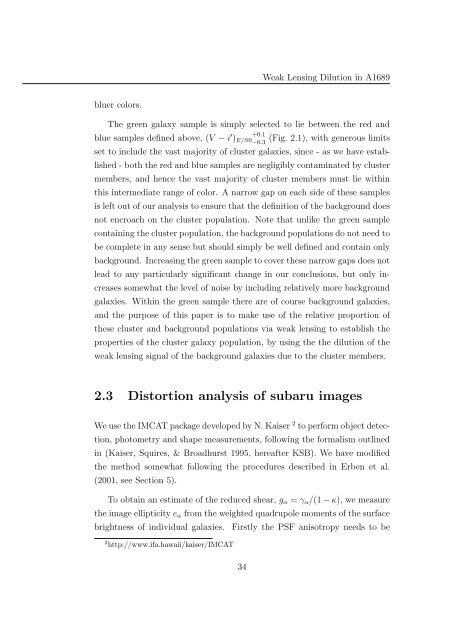Mass and Light distributions in Clusters of Galaxies - Henry A ...
Mass and Light distributions in Clusters of Galaxies - Henry A ...
Mass and Light distributions in Clusters of Galaxies - Henry A ...
You also want an ePaper? Increase the reach of your titles
YUMPU automatically turns print PDFs into web optimized ePapers that Google loves.
Weak Lens<strong>in</strong>g Dilution <strong>in</strong> A1689<br />
bluer colors.<br />
The green galaxy sample is simply selected to lie between the red <strong>and</strong><br />
blue samples def<strong>in</strong>ed above, (V − i ′ +0.1<br />
) E/S0 (Fig. 2.1), with generous limits<br />
−0.3<br />
set to <strong>in</strong>clude the vast majority <strong>of</strong> cluster galaxies, s<strong>in</strong>ce - as we have established<br />
- both the red <strong>and</strong> blue samples are negligibly contam<strong>in</strong>ated by cluster<br />
members, <strong>and</strong> hence the vast majority <strong>of</strong> cluster members must lie with<strong>in</strong><br />
this <strong>in</strong>termediate range <strong>of</strong> color. A narrow gap on each side <strong>of</strong> these samples<br />
is left out <strong>of</strong> our analysis to ensure that the def<strong>in</strong>ition <strong>of</strong> the background does<br />
not encroach on the cluster population. Note that unlike the green sample<br />
conta<strong>in</strong><strong>in</strong>g the cluster population, the background populations do not need to<br />
be complete <strong>in</strong> any sense but should simply be well def<strong>in</strong>ed <strong>and</strong> conta<strong>in</strong> only<br />
background. Increas<strong>in</strong>g the green sample to cover these narrow gaps does not<br />
lead to any particularly significant change <strong>in</strong> our conclusions, but only <strong>in</strong>creases<br />
somewhat the level <strong>of</strong> noise by <strong>in</strong>clud<strong>in</strong>g relatively more background<br />
galaxies. With<strong>in</strong> the green sample there are <strong>of</strong> course background galaxies,<br />
<strong>and</strong> the purpose <strong>of</strong> this paper is to make use <strong>of</strong> the relative proportion <strong>of</strong><br />
these cluster <strong>and</strong> background populations via weak lens<strong>in</strong>g to establish the<br />
properties <strong>of</strong> the cluster galaxy population, by us<strong>in</strong>g the the dilution <strong>of</strong> the<br />
weak lens<strong>in</strong>g signal <strong>of</strong> the background galaxies due to the cluster members.<br />
2.3 Distortion analysis <strong>of</strong> subaru images<br />
We use the IMCAT package developed by N. Kaiser 2 to perform object detection,<br />
photometry <strong>and</strong> shape measurements, follow<strong>in</strong>g the formalism outl<strong>in</strong>ed<br />
<strong>in</strong> (Kaiser, Squires, & Broadhurst 1995, hereafter KSB). We have modified<br />
the method somewhat follow<strong>in</strong>g the procedures described <strong>in</strong> Erben et al.<br />
(2001, see Section 5).<br />
To obta<strong>in</strong> an estimate <strong>of</strong> the reduced shear, g α = γ α /(1 − κ), we measure<br />
the image ellipticity e α from the weighted quadrupole moments <strong>of</strong> the surface<br />
brightness <strong>of</strong> <strong>in</strong>dividual galaxies. Firstly the PSF anisotropy needs to be<br />
2 http://www.ifa.hawaii/kaiser/IMCAT<br />
34
















